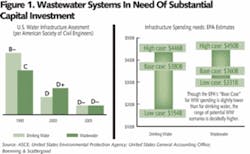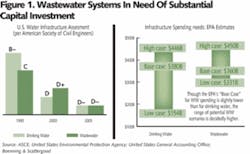Recent Trends Make Wastewater Sector Attractive Source of Growth
by Ryan M. Connors
As resources are stretched thin due to growth and development and not just in the more arid West, wastewater reuse largely for irrigation has grown more popular to reduce freshwater withdrawals and stretch potable supplies. It’s a stressful issue. Witness recent drying up of reservoirs near Atlanta due to drought and concern by Southeast states about proposals to expand Georgia’s network of dams. The future value of wastewater was underscored also by an auction in Prescott, AZ, to sell rights to the city’s effluent with the winning bid at over $67 million for 2,724 acre-feet. In much of the Southwest it’s already acknowledged these resources must eventually supplement drinking water, whether through groundwater injection and recovery or treated and delivered directly.
Likewise, wastewater treatment equipment and service companies are growing more popular to investors. Traditionally, it’s been the drinking water sector that typically attracted investors. The wastewater arena is almost as large, however, and represents an attractive source of supplemental growth for both water utilities and providers of water-related equipment and technology. Overall, it’s a vital piece of the puzzle for investors seeking to position their portfolios to benefit from the increasing value of water resources.
Like the drinking water industry, the wastewater market is highly fragmented, with over 16,000 independent systems nationwide. Its less austere pricing regulation most wastewater utilities don’t operate under the “regulated return” framework of the drinking water sector has led some utility executives to make wastewater a focus of their corporate growth strategy. This key difference between the two sectors has profound ramifications for all stakeholders, including both wastewater utilities and technology providers.
The considerable spending on the horizon (with over $350 billion required over the next 15 years to keep wastewater systems running smoothly, the EPA says) provides ample growth opportunities within the wastewater sector. For related equipment and technology providers, rehabilitation of aging wastewater systems should result in growing demand for years to come. The EPA’s analysis of spending requirements in both the water and wastewater sectors suggests wastewater infrastructure needs are actually more urgent than those on the drinking water side, which will drive demand for vital equipment and technology including pumps, pipelines, and advanced treatment equipment.
Consolidation will provide an additional source of growth for investor-owned utilities making the strategic decision to enter the wastewater sector, and will help to enable infrastructure spending. Many of the wastewater systems across the United States are very small, despite the fact the wastewater business is subject to economies of scale and larger players are more likely to be financially self-sustaining. Given the need for substantial infrastructure upgrades nationwide, many small systems are finding it increasingly difficult to stay afloat making consolidation inevitable. Most important, wastewater utilities typically enjoy a greater level of flexibility in pricing their product according to its true value, and are better positioned to achieve full-cost pricing believed to be necessary in order for both the water and wastewater sectors to realize their investment potential.
Growth in the wastewater sector will be driven by both organic customer growth and steady price increases. The Environmental Business Journal projects 5% revenue growth for wastewater utilities vs. 4% for drinking water utilities. Wastewater utilities across the nation will put these funds to work both in building-out their systems to accommodate rapidly expanding populations and in making much-needed upgrades to existing infrastructure. Thus, the wastewater sector is primed for steady, sustainable demand growth for years to come.
About the Author: Ryan M. Connors is a senior research analyst with Boenning & Scattergood, Inc., an independent investment firm in the Mid-Atlantic region since 1914. Connors covers industrial equipment and services companies, focusing on growing and profitable basic industrial sectors such as water equipment & distribution and specialty chemicals. Contact: 610-832-5217 or [email protected]

